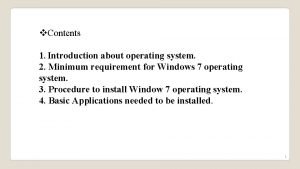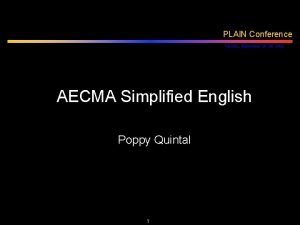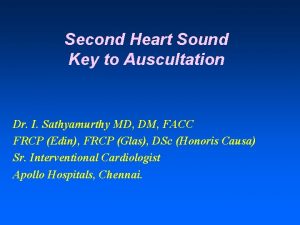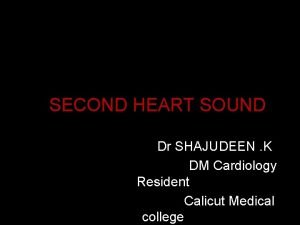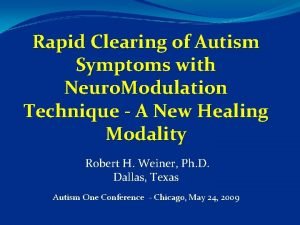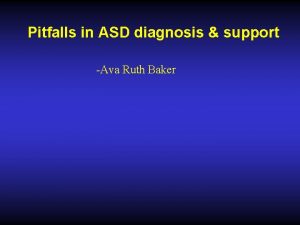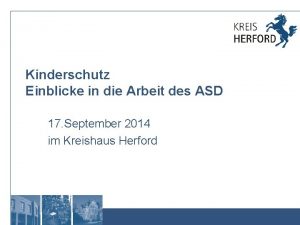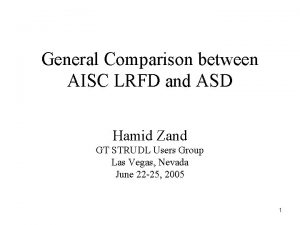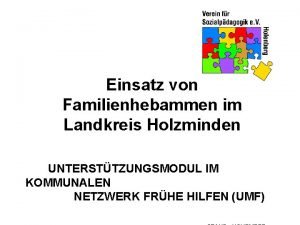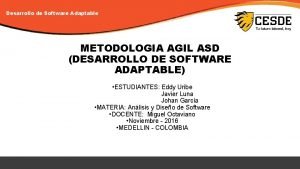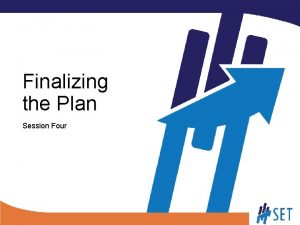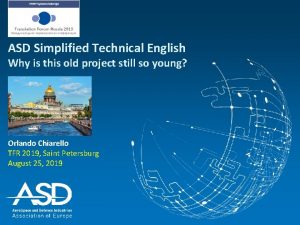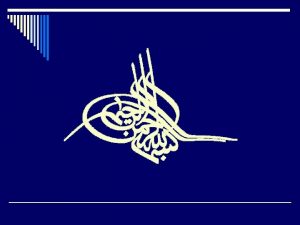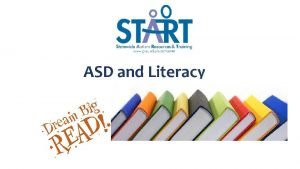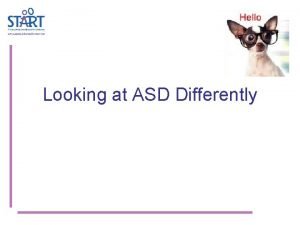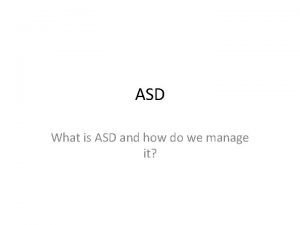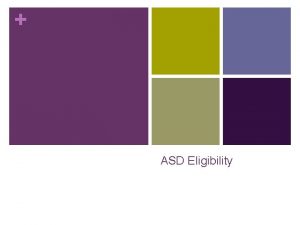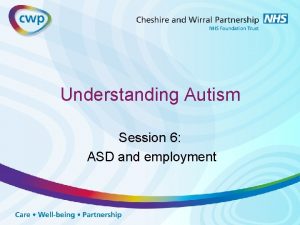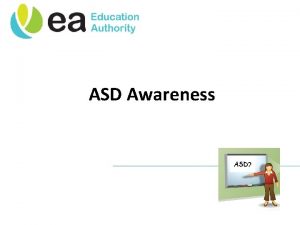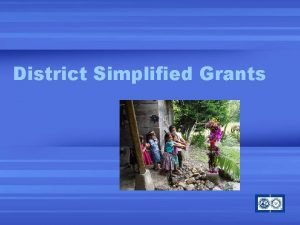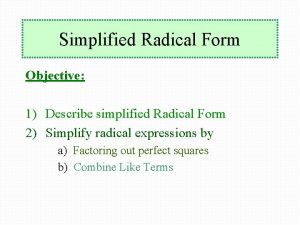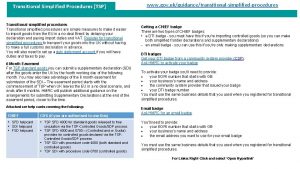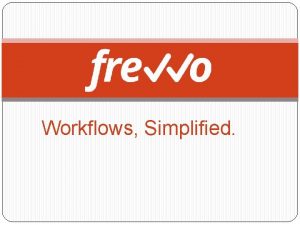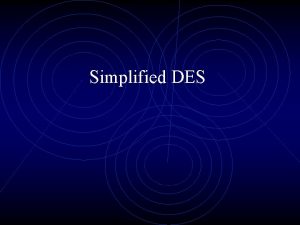ASD Simplified Technical English Finalizing a new edition

















- Slides: 17

ASD Simplified Technical English Finalizing a new edition in COVID-19 times Orlando Chiarello TFR 2020 August 22, 2020

ASD Simplified Technical English What is it? Why ASD? ASD (formerly known as AECMA) is the voice of European Aeronautics, Space, Defense and Security industries Why ENGLISH? Is the international language of engineering and science Why SIMPLIFIED? To eliminate problems of comprehension (especially for non-native speakers) Why TECHNICAL? Intended for all technical texts Why 100? Assigned as a “tribute” to ATA 100, the first international specification which, in 1987, included the requirement to write in accordance with STE 2

Short history of ASD-STE 100 Ø In the late 1970 s, the Association of European Airlines (AEA) asked the European Association of Aerospace Industries (AECMA, now ASD) to investigate the readability of maintenance documentation in the civil aircraft industry and find a solution to simplify the language used to write such documentation. Ø AECMA asked the Aerospace Industries Association (AIA) of America to assist in this project. Two groups from AECMA and AIA were formed for the scope. Ø The resulting conclusion confirmed the need for a simplified language. Ø In 1983, the AECMA Simplified English Working Group was founded and the project started. The product of such effort was the AECMA Simplified English Guide (first release in 1986) which later (in 2005) became the ASD-STE 100, Simplified Technical English Specification. 3

Short history of ASD-STE 100 From a simple guide to an international specification From “aircraft maintenance documentation” to “technical documentation” 4

ASD Simplified Technical English In brief, STE: Ø Is a set of writing rules (53, in 9 sections) and a dictionary of controlled vocabulary (864 approved words). Ø Makes technical texts easy to understand especially for non-native speakers of English. Ø Has a controlled general vocabulary with sufficient words to write all technical sentences. Ø Is adaptable and flexible. Ø Is not a terminology glossary but permits the use of defined and company terminology (project glossaries applicable to specific industry fields) Ø Permits the use of technical terms (nouns and verbs). Ø Permits the use of only one language for technical documentation. Ø Can helps the translation of English texts into other languages. Ø Can help the Machine Translation process. Ø Where necessary, helps the creation of other controlled languages different from English. 5

STE and translation Ø There are tremendous benefits that a controlled language can have in the translation process. Ø When STE was created one of its primary objectives was to make translation easier. Ø If the vocabulary, meanings of words, and types of sentence constructions are controlled, the variation between texts will be minimal. Ø Thus, it is easier for translators or translation engines to translate texts written in one controlled language into a target language. Ø Besides STE, it is of paramount importance a customized terminology database that includes technical terms (technical names and technical verbs). 6

Who uses ASD-STE 100? ASD-STE 100 was developed for the aviation industry and it is a requirement of the major specifications used for writing technical publications. Today: 54% of the STE users are outside aerospace and defense Copies of the STE specification have been requested by: Ø 113 different countries worldwide (63% outside Europe) Ø More than 300 universities worldwide Ø Many Important companies in various sectors of industries NOTE: The above logos are only examples 7

Who uses ASD-STE 100? USERS (Data from the STEMG distribution log, Issue 7, January 2017, updated August 17, 2020) USER SCENARIO - Fields of activity COPIES %ISSUE 7 Aerospace and Defense (including Government Agencies) 2325 36% Language Services, Translation Services, Technical Documentation 875 14% Information Technology, Hi-Tech, Software, Telecommunications 722 11% Airlines and Air Forces 623 10% Academics, Education and Research 414 6% Automotive, Railways and Transportation (including Sea transportation) 329 5% Others (different branches of industry) 313 5% Mechanical engineering, manufacturing, and processes 242 4% Energy (Oil, gas, electricity, nuclear, mining, etc. ) 223 4% Medical and Healthcare 196 3% Private (personal use) 110 2% Industrial machinery 30 0% TOTAL 6402 100% 8

The STEMG ASD-STE 100 is maintained by the: ASD Simplified Technical English Maintenance Group (STEMG) The STEMG is a non-profit group of professionals, consisting of representatives from ASD member countries and non-ASD member countries. It also includes representatives from the airlines. 9

The new Issue 8 The STEMG is working on a new edition of STE (ISSUE 8) which will be released on April 30, 2021 10

The new Issue 8 Ø Work on Issue 8 started in Moscow in May 2017. Ø The first DRAFT was produced in six 4 -day meetings (2017, 2018, 2019). Ø Issue 8 was planned to be finalized in the last three 4 -day meetings (Spring 2020, Fall 2020, and Spring 2021). Ø Because of the COVID-19, the STEMG was forced to cancel the two 2020 meetings and keep only the Spring 2021 meeting as scheduled (but, due to possible residuals of the pandemic situation and travel restrictions, we are prepared to cancel also this one). Ø The major problem now is that, due to the STEMG working practices, plenary online meetings are not productive. Ø Time zones are also a problem (six different time zones, Argentina, USA, UK, Europe, Russia, and Japan). Ø In July, for the first time in the STEMG history, the meeting was held online (1 day). Ø The decision was to go ahead as planned and release Issue 8 on April 30, 2021. 11

The new Issue 8 Ø An emergency strategy and work plan was agreed. Ø The STEMG was divided into four small groups. Ø A coordinator was appointed for each group. Ø The groups started working independently under the directives of their coordinators. GROUP 1 4 members GROUP 2 5 members GROUP 3 4 members GROUP 4 5 members Coordinated by the German representative Coordinated by the Russian representative Coordinated by the Argentinian representative Coordinated by the US representative 12

The new Issue 8 Starting from Issue 8 – DRAFT 1 (May 11, 2020) GROUP 1 GROUP 2 GROUP 3 GROUP 4 is working on Sections 1 and 2 Letters D, I, J, M, O, and V is working on Sections 6, 7, and 8 Letters B, N, R, S, T, X, Y, and Z is working on Sections 4 and 5 Letters C, E, F, G, K, and U is working on Sections 3 and 9 Letters A, L, P, Q, and W The tasks of the groups are: 1. Review the assigned material for accuracy and all areas of improvement. 2. Identify errors, possible changes or improvements, particularly in the examples in the dictionary (universal use of STE can also be considered). 3. Collect all findings in a dedicated report for final discussion at the next meetings or plenary review. 13

The new Issue 8 For the first time in the history, starting from December, Issue 8 – DRAFT 2, November 30, 2020, will be available for proofreading, comments, and suggestions to all STE users who would like to help on this new edition. Information on how to get this draft copy will be available on the STEMG website and Facebook page 14

To conclude – Practical examples How to make Borscht Non-STE • • STE In a large saucepan, combine the beets, carrots, onion and broth; bring to a boil. Reduce heat; cover and simmer for 30 minutes. Add tomatoes and cabbage; cover and simmer for 30 minutes or until cabbage is tender. Stir in salt, dill and pepper. Top each serving with sour cream if desired. 1. Put these ingredients in a large saucepan: Beets Carrots An onion The broth. 2. Supply heat until the ingredients boil. 3. Decrease heat. 4. Put a cover on the saucepan. 5. Boil slowly at low temperature for 30 minutes. 6. Remove the cover. Then, add tomatoes and the cabbage. 7. Put the cover again. 8. Boil slowly at low temperature for 30 minutes or wait until the cabbage becomes soft. 9. Remove the cover. Put salt, dill and pepper. 10. Remove the saucepan from the heat source. 11. Prepare the applicable servings for each person. 12. Add sour cream to each serving, as necessary. Technical names Technical verbs 15

To conclude – Practical examples How to use the medical mask Non-STE Before putting on a mask, clean hands with alcohol-based hand rub or soap and water. Cover mouth and nose with mask and make sure there are no gaps between your face and the mask. Avoid touching the mask while using it; if you do, clean your hands with alcohol-based hand rub or soap and water. Replace the mask with a new one as soon as it is damp and do not re-use single-use masks. To remove the mask: remove it from behind (do not touch the front of mask); discard immediately in a closed bin; clean hands with alcohol-based hand rub or soap and water. STE 1. 2. 3. 4. 5. 6. 7. 8. 9. Before you use the mask, clean your hands with an alcohol-based hand rub or a soap and water solution. Put the mask on your mouth and nose. Make sure that there are is no distance between your face and the mask. Do not touch the mask when you use it. If you touch the mask, clean your hands with an alcohol-based hand rub or a soap and water solution. If the mask becomes moist, replace it. Do not use single-use masks again. Remove the mask from your rear side. Do not touch the front of the mask. Discard the mask immediately and put it in a closed container. Clean your hands with an alcohol-based hand rub or a soap and water solution. Technical names 16

Thank you for you attention! See you at TFR 2021 for a detailed presentation of the new ISSUE 8! More information about STE: Please visit: www. asd-ste 100. org Please contact: stemg@asd-ste 100. org Please visit the STEMG Facebook page Follow the STEMG on Twitter @asd_stemg Get in contact with the STEMG on Linkedin Request a free copy of STE www. asd-ste 100. org Over 100 Years of History AND AEROSPACE TECHNOLOGY Orlando Chiarello Product Support Manager of Secondo Mona S. p. A. Chairperson, ASD Simplified Technical English Maintenance Group (STEMG) orlando. chiarello@secondomona. com Simplified Technical English, ASD-STE 100, is a Copyright and a Trade Mark of ASD, Brussels, Belgium 17
 Asd ste
Asd ste Windows is finalizing your settings
Windows is finalizing your settings Aecma simplified english
Aecma simplified english Mis chapter 6
Mis chapter 6 Report
Report Asd
Asd Splitting of second heart sound
Splitting of second heart sound Fixed splitting of s2
Fixed splitting of s2 Pddbi score interpretation
Pddbi score interpretation Dr ava ruth baker
Dr ava ruth baker Asd herford
Asd herford Lrfd asd
Lrfd asd Landkreis holzminden jugendamt
Landkreis holzminden jugendamt Software asd
Software asd Tetralogy of fallot
Tetralogy of fallot Wake tech admissions
Wake tech admissions Asd 3000l
Asd 3000l Asd 3000l
Asd 3000l

